
|
|
Left London
William Eckersley and Alexandrer Shields
Stucco
ISBN 0-9553143-0-5
Londoners could be mistaken in thinking their city was under siege. With the forthcoming Olympic
developments bulldozing a huge swathe through the east end, the ill conceived demolition of Wembleyís
twin towers and the potential toppling of Batterseaís cooling stacks, the capital seems to be changing
at ever increasing rates.
With the exception of the popular Derelict London website, the capitalís many derelict and disappearing
haunts remain undocumented and unrecorded in their final throes. Urban explorers, perhaps unwilling to pay
the congestion charge, limit themselves to the periphery, circling the capital and picking off the odd asylum
in their path. Derelict London itself is an unsatisfying prick tease; all bluster and talk, with no penetration,
no satisfying probing of the interiors.
This is where Left London succeeds. The first book by Stucco Press is also the
first to get to grips with the capitalís derelict landscape. Travelling the length and breath of Londonís sprawl
over the course of a year, photographers Alexander Shields and William Eckersley
immersed themselves in Londonís lost, decaying and decrepit places, recording the final vistas of ruination,
and finding unexpected beauty and grandeur as the old buildings succumbed to nature or the bulldozer.
Whilst completing a Masters course at Central Saints Martin, Shields' initial idea was to
create artistic installations within derelict places, using the shattered surroundings at backdrops to his work.
He then discovered the backgrounds were far more interesting, and embarked on quest, aided by architectural
photographer Eckersley. The resulting thousands of pictures whittled down, sorted into categories
and presented as a thick, glossy coffee table book, became an alternative guide to London.
Targeting into industry, transport, health and leisure (which became the four chapters of the book), Shields and
Eckersley scrambled around old mills, walked track beds, infiltrated hospitals and asylums, and breached
social clubs and lidos. Their first forays sometimes became unwitting epitaphs, as the demolition teams moved
in and reduced the buildings to rubble before their return trip. This served to emphases the transient nature
of the capitalís derelict places, the dynamism of the genres following them, and the poignant reminder that nothing
lasts forever.
They captured the eerie wonders found within derelict places perfectly. The operating theatre at Putney Hospital with
lighting still burning; a desk at Cane Hill with a phone angled as if to be waiting for a call, the empty Lidos
just requiring a quick top-up. They also captured the buildingsí temporary last uses: as graffiti artistsí canvasses,
urban explorersí wildernesses and arsonists wet dreams.
Apart from Telegraph journalistís Gervase de Wildeís introduction, the book features
no text. To try to contextualise and rationalize the images would time consuming, space wasting and, ultimately,
would detract from the bold, colour pictures themselves. To repeat a hackneyed phrase, the pictures do tell their own,
somewhat morbid, sad, stories.
Weighing in at 170 pages, Left London is a hefty tome, packed with colour pictures of strangeness and stillness.
Urban explorers will be familiar with some of these places, but Shields and Eckersley find new
ways to represent them. (For example, their photographs of the extensively covered Cane Hill offer some new views and
unexplored areas, a fresh viewpoint on an overexposed subject). For that, and all the other pages, this book should
definitely be tracked down.
For copies and further information: www.leftlondon.co.uk
|
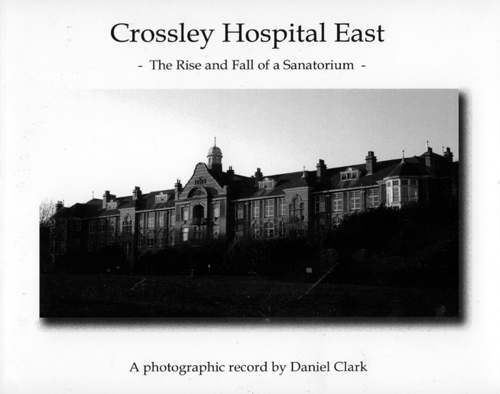
|
Crossley Hospital East
The Rise And Fall Of A Sanatorium
Daniel Clark
The Scientific Press Ltd, London
One of my critiques of urban exploration, especially when used as a modus operandi for
a higher purpose, is the sheer randomness of the entire process. Documenting a building
entirely is difficult, especially if evading patrols, sneaking past PIRs
and blocked by barricades.
Imagine the possibilities if given the opportunity to do it properly, unfettered by
chance and circumstance.
Offered such an opportunity, Daniel Clark grabbed it with both hands. His passion,
Crossley Hospital East, a former Sanatorium lost in the woodland of Delamere, Cheshire,
had been lying derelict for over ten years. With permission, Clark photographed its
decaying exteriors and lost interiors. This book is the result.
Professionally bound and printed using high quality paper, the 94 page book offers a short
history of the institution, then takes the reader around the exteriors before diving
in the dilapidated interiors and culminates with the ancillary buildings scattered
around the site. Combining the vastness of empty wards, stairwells and communal
spaces with the miniature of abandoned furniture and rusting fixtures, the book
confers both the size of the institution and glimpses of the human stories that
undoubtedly played out there.
Crossley Hospital East is not a history of the hospital, nor offers any opinions
or solutions to the buildingís predicament. It simply shows it how it was (using a small
selection of archival photos) and how it is now. It is a picture book where the hospital
tells its own story.
The pictures are black and white and taken in winter. This conspires to make the location
noticeably bleak and flat, losing the beauty and detail of any coloured brickwork and stone.
This is my only main criticism, which is purely subjective at best, as the pictures are
beautifully taken and framed. There is also noticeable pixilation in a couple of shots, which
betrays digital origins, but doesnít detract.
Those who like derelict places, and the delay and beauty of these fragile places,
should purchase a copy.
Additionally those interested in the documentation and photographic preservation
of derelict and lost places, and who want their work recognised and immortalized,
should definitely buy this book. Itís the way forward. It shows whatís possible. For
that, itís is extremely important.
For copies and further information: www.crossleysanatorium.co.uk
|
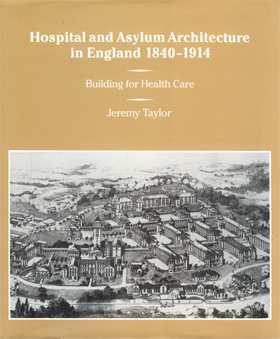
|
Hospital and Asylum Architecture in England 1840-1914
Building for Health Care
Jeremy Taylor
ISBN 0-7201-2059-4
Published in 1991, Jeremy Taylorís comprehensive and detailed study is now almost impossible to find. But
if you can locate a copy, then itís definitely worth purchasing if youíre interested in the development of the
asylum.
Twenty eight pages are devoted to the rise of the Victorian and Edwardian asylums - from ad-hoc designs
through the corridor, radiating pavilion, echelon and colony patterns. Many urban exploration favourites are
covered, and Taylor supplies comprehensive lists of asylums, architects and projects.
Taylorís lists were subsequently used by SAVE to compile their own report (see below).
|
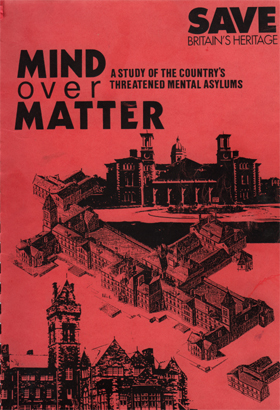
|
Mind Over Matter
A Study Of The Country's Threatened Mental Asylums
Published by Save Britainís Heritage, this list of Victorian and Edwardian asylums formed the basis of my
own asylum list. But this 150 page booklet features much more than my summary. Along with a picture of
each asylum (some of which werenít the most flattering), thereís a section on the buildingís history, usage,
and forthcoming plight.
Thereís also essays on asylums, the landscaping of their grounds and the development of their architecture.
Itís now totally out of date, being written in the early nineties, and sad to say, most of the buildings have
now gone or are being converted.
But itís an excellent resource and I recommend purchasing a copy from
SAVEís website.
|
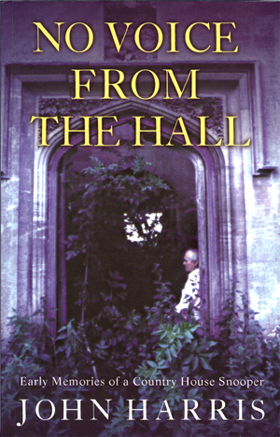
|
No Voice From The Hall
Early Memories of a Country House Snooper
John Harris
ISBN 0-7195-6149-3
"The demolition of these houses is a tragic story, but the author's battles with weather and hostile caretakers, and his discovery
of unexpected treasures, are entertaining and beautifully written." Eric Anderson, Sunday Telegraph
John Harris: proto urban explorer. Not that he'd ever call himself that, preferring the more mischevious
"country house snooper". But this book is the precursor to everthing on this website; except his snooping lead him to become a member of the
RIBA staff and to work for Pevsner (several times).
Harris concentrates on the glut of country houses left to rot after the war (in a similar way that I seek out
asylums) and his wealth of pictures and incredible stories of cheek and cunning are a delight.
What he saw, and explored, and watched being demolished, is amazing. The urban landscape has changed, society has changed, but all his methods
(even down to pretending to be relatives of the owner of the building) could still be used today.
|

|
Echoing Voices
More Memories of a Country House Snooper
John Harris
ISBN 0-7195-6492-1
Echoing Voices covers Harris' early life, reading as an expanded version of the Prologue of the first book. In some
ways, this book should be read first, as it sets the scene for No Voice From The Hall. And it also paints a picture of the wild,
almost unruly Harris, and some of the (dangerous) adventures he got caught up in.
And then there are the tales of sneaking around country estates, or simply racing up private roads, snatching photographs, and
wheel spinning away on their gravel drives.
"By 1939 a frisson went through Cliff Villas whenever we arrived, due soley to my rebellious behaviour. Over the years I
broke up the toilet bowl with a hammer; let loose six white mice in the 'best' front room... and melted brown boot polish into the
large bowl of dripping that always stood on the table in the kitchen, where bread and dripping was a staple."
And then there was the time he got bored on a country house tour and feigned a heart attack... I can understand that.
|
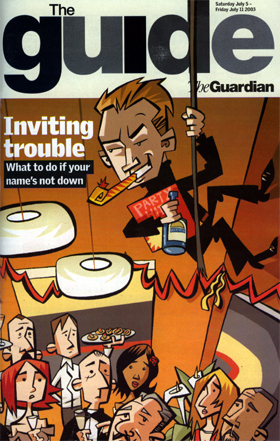
|
The Guide July 5th 2003 (listing suppliment for The Guardian)
Pipe Down
Hugh Wilson's piece was written after talking to the many tunnellers and cavers who cluster about the Nettleden
community. This resulted in a underground slant to the first published piece about urban exploration
in the UK, but Wilson did some homework, and some non subterranean locations were mentioned.
Yes, he did some homework - but the underlying representation of the urban explorer, bolstered by the graphic
illustrations, was of an exclusively male group, a touch geeky, and unlikely to go anywhere without some
weak lemonade drink.
Iím being a little unkind - the comments and quotes were spot on, detailing why we explore urban locations,
and the thrills and spills to be experienced. It also covered the grey legal areas of trespass and concluded that
urban exploration isnít a police priority.
ďOld military complexes and abandoned lunatic asylums are often considered to be the pinnacle of UE.Ē
Well, thatís me then.
|
|